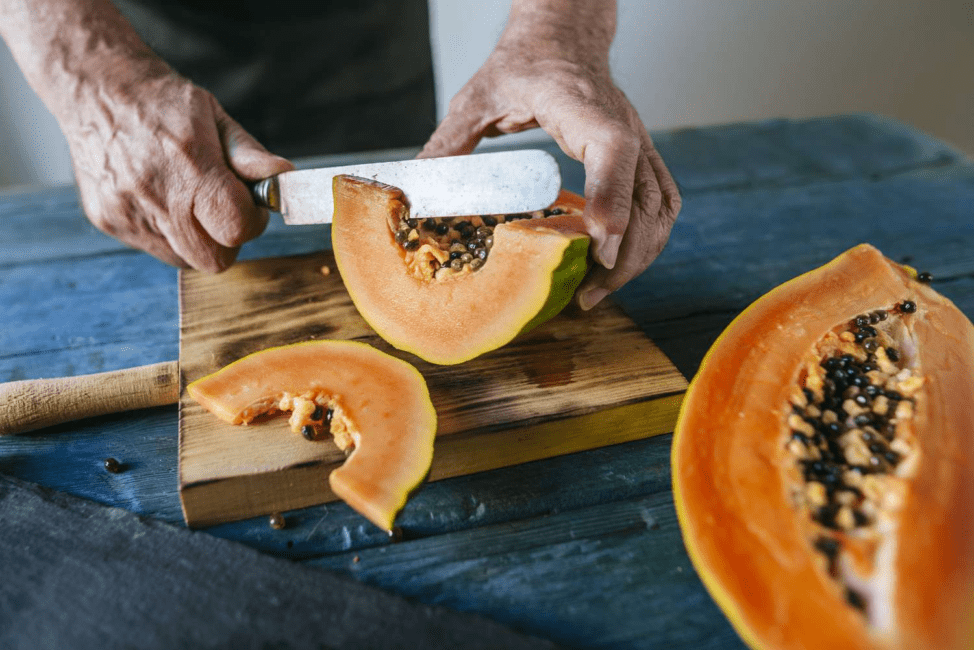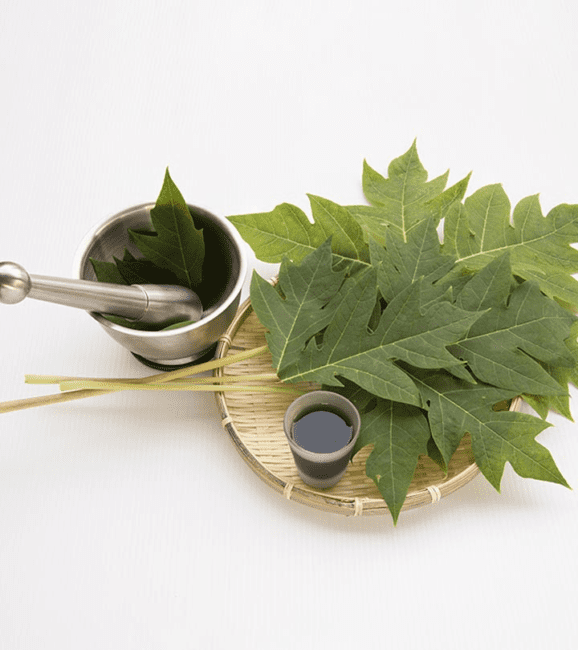The PawPaw/Papaya pistil is the female reproductive organ located at the center of the flower. It comprises three main parts: the stigma, style, and ovary. The stigma is the receptive surface where pollen grains land during pollination.
The style is a slender tube that connects the stigma to the ovary, providing a pathway for pollen tubes to reach the ovules within the ovary. The ovary houses the ovules, which contain the female gametes (eggs) needed for fertilization.
The primary function of the PawPaw/Papaya pistil is to facilitate the process of fertilization and fruit development. When pollen grains land on the stigma, they germinate and form pollen tubes that travel down the style to reach the ovules within the ovary. Once the pollen tubes reach the ovules, fertilization occurs, resulting in the formation of seeds within the developing fruit. The ovary then undergoes transformation into the mature fruit, while the stigma and style may senesce or persist depending on the species.
PawPaw/Papaya flowers exhibit a unique mechanism of pollination, primarily relying on cross-pollination facilitated by insects such as bees and butterflies. The bright colors and aromatic fragrance of the flowers attract pollinators, encouraging them to visit multiple flowers and transfer pollen between plants. While some PawPaw/Papaya varieties are capable of self-pollination, cross-pollination often results in higher fruit set and quality due to increased genetic diversity.
Several factors influence the health of the PawPaw/Papaya pistil and subsequent fruit production. Adequate pollinator populations, favorable weather conditions, and proper cultural practices contribute to optimal pollination and fertilization. Conversely, factors such as inadequate pollinator activity, extreme temperatures, moisture stress, and nutrient deficiencies may hinder pistil function and reduce fruit yield and quality.
The Economic Importance and Uses of PawPaw/Papaya Pistil
1. Fruit Production: The PawPaw/Papaya pistil plays a central role in fruit production by facilitating the process of fertilization. Without successful fertilization initiated by the pistil, fruit development cannot occur. PawPaw/Papaya fruits are highly sought after in both local and international markets for their sweet flavor and nutritional value, contributing significantly to the agricultural economy.
2. Seed Production: Beyond fruit production, the PawPaw/Papaya pistil is instrumental in seed production. Following successful fertilization, the ovules within the pistil develop into seeds that are essential for the propagation of PawPaw/Papaya plants.
These seeds are valuable commodities traded by growers and seed companies for the cultivation of new crops and the development of improved PawPaw/Papaya varieties.
3. Horticultural Research: The PawPaw/Papaya pistil is of great interest to horticultural researchers and breeders seeking to improve fruit quality, yield, and disease resistance. By studying the pistil’s structure and function, researchers can gain insights into the reproductive biology of PawPaw/Papaya plants and develop innovative breeding strategies to enhance crop productivity and resilience to environmental stressors.
4. Medicinal and Nutritional Uses: While the PawPaw/Papaya pistil itself may not have direct medicinal or nutritional uses, the fruits produced as a result of successful pistil function are rich in vitamins, minerals, and antioxidants. PawPaw/Papaya fruits are consumed fresh, dried, or juiced and are renowned for their digestive health benefits, immune-boosting properties, and potential anti-inflammatory effects.
5. Cosmetic and Pharmaceutical Industries: Extracts derived from PawPaw/Papaya fruits, which owe their existence to the pistil’s reproductive function, are utilized in cosmetic and pharmaceutical products. PawPaw/Papaya extracts are valued for their skin-rejuvenating properties and are incorporated into skincare formulations such as creams, lotions, and serums. Additionally, PawPaw/Papaya enzymes are used in pharmaceutical preparations for their potential therapeutic effects.
6. Export and Trade: PawPaw/Papaya fruits and seeds produced with the assistance of the pistil contribute to international trade and export revenues for countries with tropical climates conducive to PawPaw/Papaya cultivation. These fruits are exported fresh or processed into value-added products such as purees, concentrates, and dried fruits, catering to global consumer demand for exotic and nutritious tropical fruits.
7. Culinary Applications: PawPaw/Papaya fruits are widely used in culinary applications, adding flavor and nutritional value to a variety of dishes. From fresh fruit salads and smoothies to cooked dishes and desserts, PawPaw/Papaya fruits enhance the sensory experience of food and provide a refreshing tropical twist to culinary creations.
8. Tourism and Agrotourism: PawPaw/Papaya orchards and farms, where pistil-assisted fruit production takes place, contribute to tourism and agrotourism industries. Visitors are drawn to these establishments to witness the natural beauty of PawPaw/Papaya trees in bloom, learn about fruit cultivation techniques, and indulge in tasting experiences showcasing the versatility of PawPaw/Papaya fruits.
Read Also: 15 Medicinal Health Benefits Of Abronia fragrans (Fragrant Sand Verbena)
The Products and By-products That Can Be Derived From PawPaw/Papaya Pistil
1. Papain Enzyme: Papain is a proteolytic enzyme extracted from the PawPaw/Papaya Pistil. It is widely used in the food, pharmaceutical, and cosmetic industries for its protein-digesting properties.
Papain is extracted through a process of crushing and macerating the Pistil, followed by enzyme extraction and purification. Examples of applications include meat tenderizers, digestive supplements, and skincare products for exfoliation.
2. Nutritional Supplements: PawPaw/Papaya Pistil contains various vitamins, minerals, and antioxidants that can be processed into nutritional supplements. These supplements are commonly used to support digestive health, immune function, and overall well-being.
The Pistil is dried and powdered, then encapsulated or formulated into liquid extracts for easy consumption. PawPaw/Papaya Pistil supplements are popular among health-conscious consumers seeking natural and holistic remedies.

3. Cosmeceutical Ingredients: Extracts derived from PawPaw/Papaya Pistil are utilized in the cosmetic and skincare industry for their exfoliating, brightening, and rejuvenating properties.
These extracts contain enzymes and antioxidants that help remove dead skin cells, promote cell turnover, and improve skin texture and tone. Cosmetic formulations such as facial scrubs, masks, and serums often incorporate PawPaw/Papaya Pistil extracts to enhance product efficacy and appeal.
4. Herbal Teas and Infusions: PawPaw/Papaya Pistil can be dried and brewed into herbal teas and infusions known for their soothing and digestive benefits. The Pistil is harvested, cleaned, and air-dried to preserve its natural flavors and nutrients. PawPaw/Papaya Pistil tea is consumed for its mild, fruity flavor and potential therapeutic effects on digestion and inflammation. It is a popular beverage choice among health-conscious individuals seeking natural alternatives to caffeinated drinks.
5. Animal Feed Additives: By-products of PawPaw/Papaya Pistil processing, such as residual fiber and biomass, can be utilized as feed additives for livestock and poultry. These by-products are rich in dietary fiber, vitamins, and minerals, providing nutritional benefits to animals. PawPaw/Papaya Pistil residues are dried, ground, and incorporated into animal feed formulations to enhance digestibility, promote gut health, and support overall animal well-being.
6. Organic Fertilizers: PawPaw/Papaya Pistil residues and biomass can be composted and processed into organic fertilizers for agricultural use. Composting PawPaw/Papaya Pistil residues with other organic materials helps create nutrient-rich compost that improves soil structure, fertility, and microbial activity.
PawPaw/Papaya Pistil compost can be applied to crops, gardens, and landscaping to enhance plant growth and yield while reducing the need for chemical fertilizers.
7. Biodegradable Packaging Materials: PawPaw/Papaya Pistil fibers can be processed into biodegradable packaging materials as a sustainable alternative to conventional plastics. The Pistil fibers are extracted, cleaned, and processed into biopolymer films and packaging products with properties such as flexibility, strength, and biodegradability.
PawPaw/Papaya Pistil packaging materials are eco-friendly and suitable for various applications, including food packaging, agricultural mulches, and disposable utensils.
8. Herbal Medicine Ingredients: PawPaw/Papaya Pistil extracts contain bioactive compounds with potential medicinal properties, making them valuable ingredients in herbal medicines and traditional remedies. These extracts are used to formulate herbal preparations for digestive disorders, inflammatory conditions, and wound healing.
PawPaw/Papaya Pistil herbal medicines are consumed orally or applied topically, providing natural and holistic solutions to various health concerns.

Frequently Asked Questions (FAQ’s) About PawPaw/Papaya Pistil
1. What is PawPaw/Papaya Pistil?
PawPaw/Papaya Pistil is the female reproductive organ of the PawPaw or Papaya flower. It plays a crucial role in the fertilization process, leading to the development of fruits.
2. What is the Botanical Name of PawPaw/Papaya Pistil?
The botanical name of PawPaw/Papaya Pistil is Carica papaya pistil. This nomenclature reflects its association with the Carica genus and the specific species, papaya.
3. How does PawPaw/Papaya Pistil contribute to Fruit Production?
PawPaw/Papaya Pistil facilitates fertilization by receiving pollen on its stigma, allowing the pollen tubes to travel down the style and reach the ovules in the ovary. This process is essential for the development of fruits.
4. What is the Unique Pollination Mechanism of PawPaw/Papaya Flowers?
PawPaw/Papaya flowers primarily rely on cross-pollination, often facilitated by insects such as bees. The vibrant colors and fragrance of the flowers attract pollinators, contributing to successful fruit set.
5. Can PawPaw/Papaya Pistil undergo Self-pollination?
While some PawPaw/Papaya varieties are capable of self-pollination, cross-pollination is often preferred for optimal fruit set and genetic diversity.
6. What Factors Affect the Health of PawPaw/Papaya Pistil?
Factors such as pollinator activity, weather conditions, moisture stress, and nutrient availability influence the health of PawPaw/Papaya Pistil, impacting fruit production.
7. How is Papain Enzyme Extracted from PawPaw/Papaya Pistil?
Papain, a proteolytic enzyme, is extracted by crushing and macerating PawPaw/Papaya Pistil, followed by enzyme extraction and purification. It finds applications in various industries.
8. What Cosmetic Benefits are Derived from PawPaw/Papaya Pistil Extracts?
Extracts from PawPaw/Papaya Pistil are utilized in cosmetics for exfoliating, brightening, and rejuvenating properties. These extracts enhance skincare products such as facial scrubs and masks.
9. Are there Medicinal Uses Associated with PawPaw/Papaya Pistil?
PawPaw/Papaya Pistil extracts contain bioactive compounds with potential medicinal properties. Research explores their use in herbal medicines for digestive health and inflammatory conditions.
10. How Can PawPaw/Papaya Pistil By-products Contribute to Sustainable Practices?
By-products like residual fiber and biomass can be used as animal feed additives and organic fertilizers, contributing to sustainable agriculture and reducing waste.
Read Also: Practical Steps to Convert Asphalt Wastes into Aggregate for New Construction

